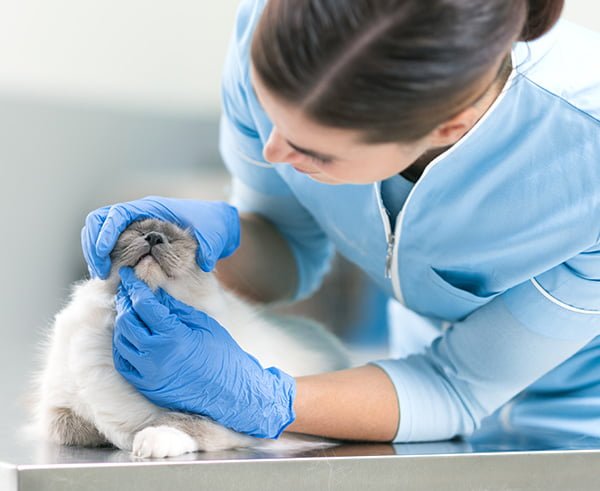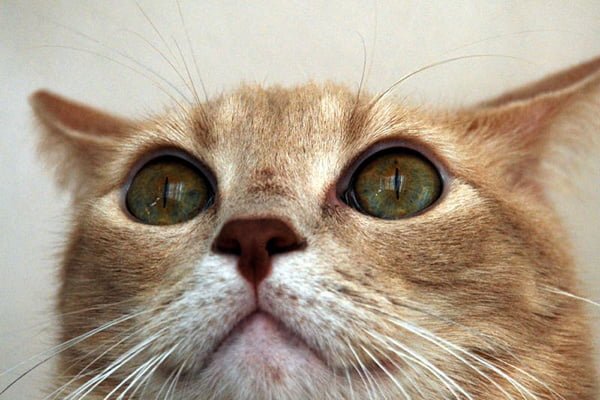We all know what it's like to deal with a pimple or two, but acne doesn't just affect people. Acne is also a common skin condition in our feline friends. In this condition, hair follicles become clogged, leading to blackheads and red bumps, mainly around the chin and lips. The cause of cat acne is not well understood but may be associated with allergies or other underlying issues. Mild cases are mostly cosmetic, but large pustules and scabs resulting from bacterial infections can be painful or irritating for your cat. Here's how you can help an acne-prone kitty and when veterinary care is recommended.
What is Cat Acne?
Cat acne is a skin condition mostly affecting the chin and lip margins in cats, and it can affect cats of any gender, age, or breed. It occurs when hair follicles become clogged, resulting in blackheads (comedones). These blocked follicles can become infected and form pimples (pustules) or boils (furuncles). It looks like a dirty chin in mild cases, and in more severe cases, the surrounding skin may also become swollen and infected.
Symptoms of Feline Acne
Feline acne most commonly occurs on the chin and the skin around the lip margins. Common clinical signs include:
- Dirty appearance to the chin
- Blackheads or clogged hair follicles
- Pustules (pimples) or larger furuncles (boils)
- Scabs or crusty skin
- Red, swollen or thickened skin
- Bleeding
- Hair loss
- Swollen chin area or lip margins in severely affected cats
Cause of Feline Acne
Acne affects cats of any breed, age, and sex. The underlying cause of feline acne is not well understood. While no one condition has been found to cause acne, there are several that may play a role, including:
Overproduction of keratin or keratinization defect - Keratin is a protein found on the skin's surface. Hair follicles can become clogged with keratin and then rupture, leading to folliculitis, furunculosis, and secondary bacterial and yeast infections.
Hyperactive sebaceous glands - When the sebaceous glands in a cat's skin produce excessive sebum, this oily substance can become trapped in the hair follicles and cause inflammation, leading to the development of acne.
Allergies - Cats can be allergic to many things, such as fleas, the protein source in their diet, or something in the environment. Common signs of allergies include itchy skin (pruritus) and chronic or recurrent skin and ear infections.
Contact hypersensitivity - Sensitivity to chemicals or substances may lead to acne. For example, there is an association between feline acne and cats who eat or drink from plastic bowls. This may be due to an allergy to plastic or the fact that plastic scratches easily, making it easier for bacteria to cling to the surface and then transfer to your cat's face.
Viral upper respiratory infections - There may be a correlation between upper respiratory viruses and chin acne in some cats.
Other skin disease - Other skin conditions, such as Demodex mites, ringworm, and eosinophilic granuloma complex, may also be associated. These conditions can appear similar to acne and also cause acne.
Immunosuppression - Cats who are immunosuppressed are more likely to develop infectious causes of acne, such as Demodex.
Poor grooming habits - Dirty, greasy, or oily skin can occur as a result of poor grooming habits and predispose your cat to acne. While most cats are fastidious groomers, some are not. Poor grooming habits may also occur due to advanced age, obesity, or underlying disease. Stress, pain, and allergies can sometimes cause cats to over groom. Both overgrooming and undergrooming can affect the health of your cat's skin. Cats licking their owners however- is not a bad habit!
Stress - Just like in people, acne in cats can pop up in times of stress, and this may be associated with changes in grooming habits and stress hormones.

How is Cat Acne diagnosed?
Your vet typically diagnoses cat acne based on history and physical exams. Examining a skin sample under the microscope (cytology) may help identify yeast or bacteria contributing to infection. Skin scrapes, bacterial, and fungal cultures may be needed to rule out other types of skin disease. Your vet may also recommend additional testing, such as bloodwork and urinalysis, to evaluate your cat's overall health and major organ function.
Cat Acne Treatment
Treatment recommendations for cat acne will depend on the severity of the acne. Mild cases may resolve without any treatment; however, if the condition persists or is bothersome to you or your cat, a vet visit for additional treatment is recommended.
Topical Medications
Mild cases of feline acne are often treated with topical treatments such as medicated wipes or ointments to the affected area. Do not use human products on your cat unless they are recommended by your vet, as these products can be too harsh on their skin. Common treatments include:
Benzoyl peroxide
Medicated wipes with antibacterial, antifungal, and anti-inflammatory properties
Anti-seborrheic, antibacterial, and antifungal shampoo
Topical antibiotic ointments, such as those containing mupirocin or clindamycin
Antibiotics
More severe cases of feline acne will require oral or injectable antibiotics to help treat bacterial infections.
Steroids
Oral or injectable steroids may also be beneficial in severe cases of acne to decrease inflammation. The most common side effects of steroid use include increased thirst, urination, and appetite. Steroids should be cautiously avoided or used in cats predisposed to heart disease or diabetes.
Manage Underlying Conditions
If your vet suspects an underlying condition, such as an allergy or upper respiratory infection, this must be addressed. Treatment may involve supplements, medication, or a prescription diet.
Improve Hygiene and Skin Health
Improved hygiene is crucial in treating feline acne. The following tips may help treat mild acne and prevent acne flare-ups:
Keep the hair on the chin clipped short to allow topical products to better penetrate the skin.
Keep your cat's face clean and dry. If your cat is a messy eater, you may have to wash its chin after meals. This is easiest to accomplish with warm water on a soft cloth. You may also use medicated cleaning wipes if recommended by your vet (see below).
If your cat tolerates it, a warm compress may feel comforting and help reduce swelling and inflammation.
While it may be tempting, never pick at your cat's acne.
Omega-3 fatty acids are beneficial for skin health.
If your cat is constantly scratching or rubbing their chin, you may need to use an E-collar for a short time to prevent them from causing further damage.
Make Changes to the Environment
If you are not already doing so, feed your cat from a ceramic, glass, or stainless steel bowl instead of plastic.
Wash food and water bowls daily to avoid the buildup of bacteria.
If your cat is overgrooming or undergrooming because of stress, consider a Feliway diffuser and see other tips from the Indoor Pet Initiative for environmental enrichment and stress reduction.
If your cat has environmental allergies, keeping the house clean and avoiding irritants like perfume may help. If your cat goes outside, washing its paws can help remove pollen and other allergens.
If food allergies are to blame, a diet change to a novel protein or hydrolyzed protein diet will be needed.
Recovery and Management
In many cases, acne will fully resolve after treatment. Other cats, however, are prone to recurrent acne flare-ups. Making the changes listed above, managing any underlying conditions such as allergies, and discussing a maintenance plan with your vet is especially important for these cats.

Source: Flickr
Cat Acne FAQs
Can Feline Chin Acne be Prevented?
The cause of feline acne is not well understood, so it is difficult to prevent. However, one simple thing that can help many cats is to use ceramic, glass, or stainless bowls for food and water. Plastic bowls have been associated with an increase in feline acne. The bowls should also be cleaned daily. Good grooming and hygiene are also important.
Is cat chin acne contagious to other cats or humans?
Luckily cat chin acne is not contagious to other cats or humans. However, it is always important to use good hygiene and wash your hands after touching or applying any topical medication to your cat's face or any open sores.
How long does it take for cat chin acne to clear up?
This will depend on the severity and underlying cause. However, most cases will resolve within two weeks of starting treatment. If the acne does not resolve or recurs, be sure to see your vet to discuss other possible causes or underlying issues.
Can a cat's chin acne be a sign of an underlying health condition?
In some cases, acne may be a sign of an underlying condition, such as an allergy, viral infection, immunosuppression, or other skin diseases.
What are the best ways to clean a cat's chin to prevent acne?
If your cat is prone to developing acne, you may clean their chin with an all-purpose medicated wipe containing antibacterial, antifungal, and anti-inflammatory properties, such as Douxo S3 Pyo Pads or Dechra Mal-a-Ket Wipes as recommended by your vet. If your cat is a messy eater, you may also need to wipe its face with warm water on a soft cloth after eating.
Is it safe to use human acne products on cats?
You should consult your veterinarian before using human products on your cat's skin. Some human products are too strong or abrasive on their skin, and many veterinary-specific products are safer and more effective for feline acne.
